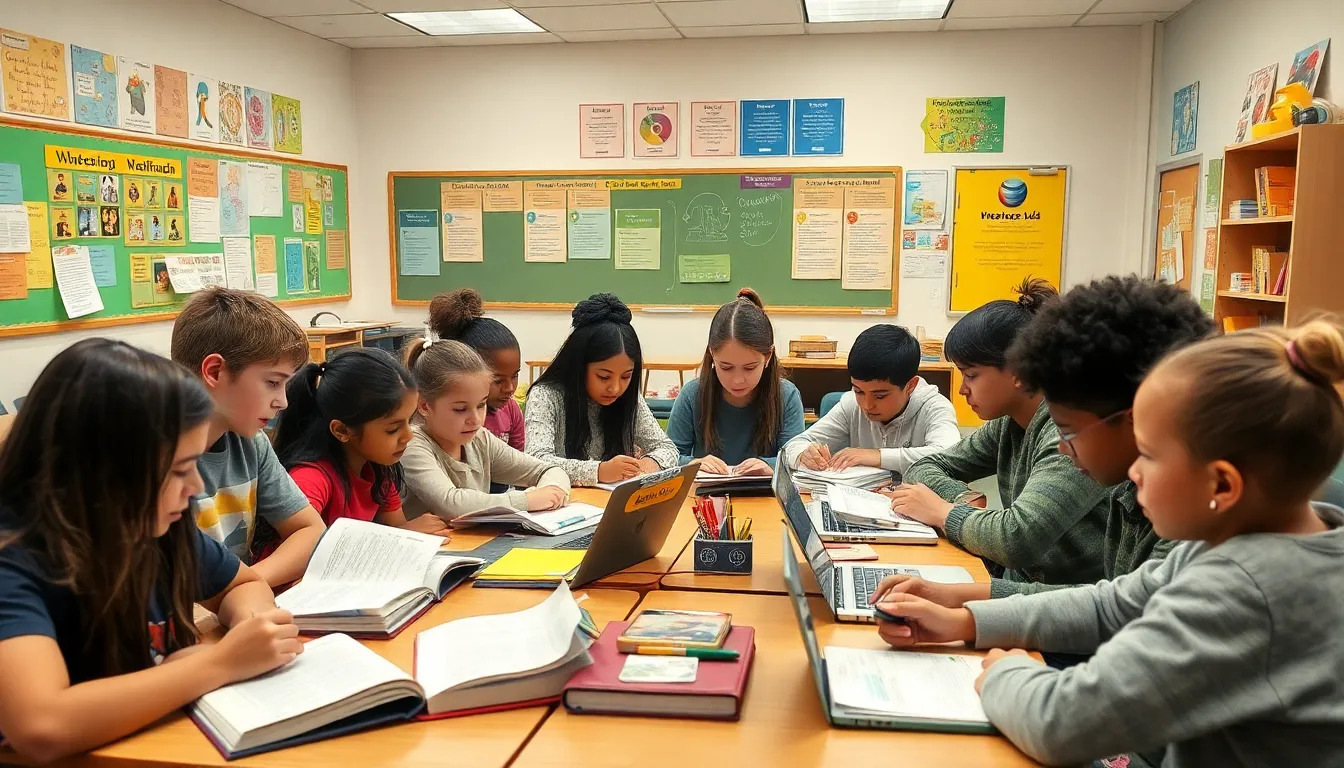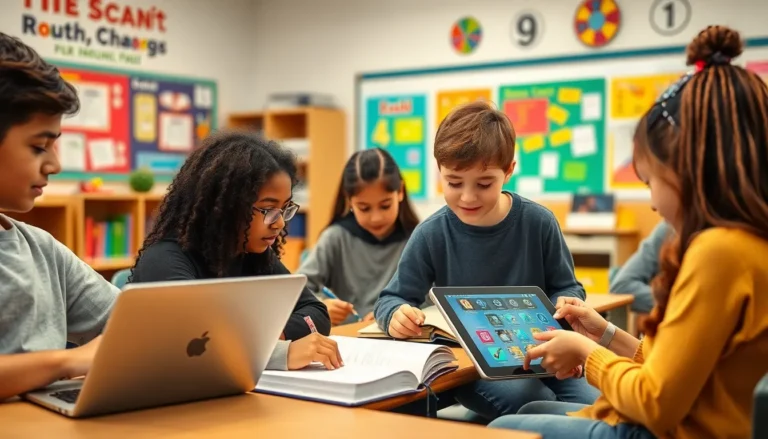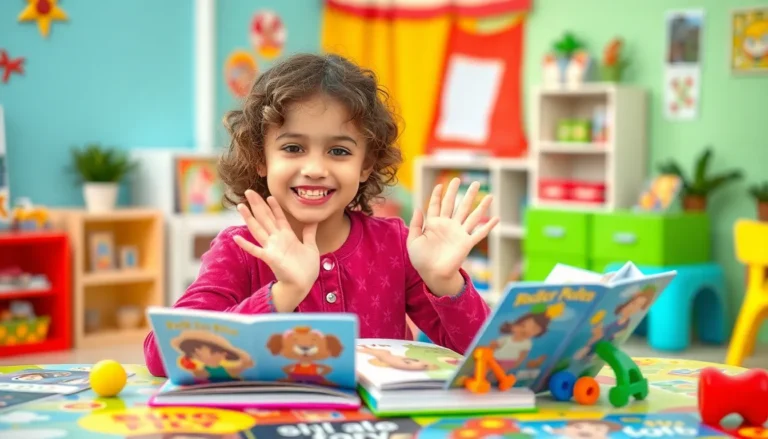In a world overflowing with information, finding the right educational resources can feel like searching for a needle in a haystack—or like trying to locate your missing sock in the laundry. With countless options at their fingertips, learners often wonder which tools can truly make a difference. Fear not! The right resources can transform a daunting educational journey into a thrilling adventure.
Table of Contents
ToggleOverview of Educational Resources
Educational resources encompass a wide range of materials and tools designed to facilitate learning. They include traditional items like textbooks and workbooks, as well as digital platforms, interactive software, and multimedia content. Finding appropriate resources can significantly impact a learner’s educational success.
Online courses present flexibility and a wealth of knowledge across various subjects. Websites like Coursera and Khan Academy provide access to lectures, assignments, and community forums. These platforms enable learners to study at their own pace, making them ideal for individuals balancing education with work or personal commitments.
Tutoring services offer personalized support to students struggling with specific topics. Whether through in-person sessions or virtual meetings, tutors can address unique learning needs. Many parents turn to platforms like Wyzant and Chegg for options that match their child’s academic challenges.
Educational apps enhance learning experiences, promoting engagement through interactive features. Apps like Duolingo for language learning and Photomath for solving math problems make study sessions more enjoyable. Learners often benefit from gamified experiences that transform traditional studying into an engaging activity.
Additionally, libraries remain invaluable educational resources. Not only do they house books, but they also offer access to online databases and research materials. Many local libraries provide free workshops and community events that encourage lifelong learning.
Conferences and webinars introduce learners to new ideas and advanced topics within their fields of interest. Educators find value in networking opportunities and knowledge sharing, ensuring they stay current with industry trends.
By utilizing a combination of these resources, learners can navigate their educational journeys more effectively, enhancing their understanding and retention of information.
Types of Educational Resources

A variety of educational resources exist to support learners. Each type plays a unique role in enhancing the educational experience.
Print Materials
Print materials remain essential in education, featuring textbooks, workbooks, and reference guides. These resources provide structured content, making complex subjects more accessible. As a foundational source of knowledge, textbooks lay the groundwork for many courses. Workbooks allow students to practice skills and reinforce learning. Reference guides serve as quick aids for clarifying concepts. Students often find these materials useful in classrooms and study sessions, enabling effective study routines.
Digital Resources
Digital resources revolutionize learning by offering flexibility and diverse content. Online platforms, such as Coursera and Khan Academy, allow learners to access courses anytime, anywhere. These courses often cover various subjects, catering to different skill levels. Mobile applications enhance this accessibility further, providing on-the-go learning opportunities. Additionally, research databases enable students to gather information quickly, assisting in assignments and projects. The convenience of digital resources fosters independent learning and self-paced studies.
Multimedia Tools
Multimedia tools enhance engagement and understanding in education. Video tutorials break down complex topics, making learning interactive and enjoyable. Educational podcasts provide auditory learning options, allowing students to absorb content while multitasking. Interactive simulations create immersive experiences, ideal for subjects like science and mathematics. Utilizing graphics and animations helps illustrate concepts more vividly. These tools not only enrich the learning process but also appeal to various learning styles, ultimately improving retention and comprehension.
Importance of Educational Resources
Educational resources play a pivotal role in the learning process, enhancing comprehension and engagement. They create pathways for students to connect with information effectively.
Enhancing Learning Experiences
Multimedia tools boost interaction through videos, podcasts, and interactive simulations. Such tools cater to various learning styles and maintain student interest. Online platforms like Coursera and Khan Academy provide flexible schedules, allowing students to study according to their pace. Interactive apps like Duolingo introduce gamified elements that transform study sessions into enjoyable activities. Engaging with diverse content keeps learners motivated and eager to explore more.
Supporting Diverse Learning Needs
Resources tailored to different learning preferences can make a significant impact. Print materials structure information in an approachable manner, while digital resources offer immediate access to varied formats. Tutoring platforms such as Wyzant and Chegg deliver personalized guidance for students facing specific challenges. Libraries serve as essential hubs, offering access to books and workshops that foster community engagement. By leveraging a mix of resources, educators can effectively support all learners, ensuring everyone has the tools they need to succeed.
Best Practices for Using Educational Resources
Maximizing the effectiveness of educational resources involves strategic approaches tailored to specific needs. Effective integration and accessibility are key aspects to consider when selecting resources.
Integration in Curriculum
Successful curriculum integration requires aligning resources with learning objectives. Educators should choose resources that complement established goals. Incorporating various formats, including textbooks, multimedia, and online tools, enhances student engagement. Additionally, blending traditional methods with digital platforms caters to diverse learning styles. Using internal assessments helps in measuring resource effectiveness. Regular feedback from students can also guide adjustments in resource utilization. Integrating resources fosters an enriching educational environment.
Accessibility Considerations
Accessibility remains essential when selecting educational resources. Providing options for different learning abilities ensures inclusivity. Text-to-speech features benefit students with reading difficulties, while captioned videos support auditory learners. Online platforms often offer adjustable content to meet individual needs. Understanding demographic factors, such as socioeconomic status, informs the accessibility of resources. Public libraries play a vital role in bridging gaps by providing free access to materials. Prioritizing resource accessibility promotes a supportive educational framework.
Future Trends in Educational Resources
Emerging trends in educational resources highlight innovative approaches to learning. Personalization stands at the forefront, enabling tailored experiences that adapt to individual learning styles. Artificial intelligence aids in curating content that resonates with specific needs, enhancing engagement.
Increased reliance on immersive technology also shapes the landscape. Virtual reality platforms provide interactive learning environments, fostering real-world application of concepts. These experiences deepen understanding, making complex topics more relatable.
The rise of collaborative learning environments is noteworthy. Online forums and group projects encourage peer interaction, enriching the educational experience. Platforms such as Slack and Discord facilitate discussions that extend beyond traditional classroom walls.
Accessibility remains a key focus in resource development. Enhanced digital materials are prioritized, ensuring all learners can engage effectively. Features like audio narration and simplified interfaces support diverse abilities, creating inclusion.
Data-driven decision-making offers valuable insights into resource effectiveness. Analytics monitor student progress, identifying areas for improvement and adjusting resources accordingly. This approach maximizes outcomes and ensures resources meet educational goals.
Government policies increasingly support innovation in educational resources. Funding initiatives promote the development of digital tools and training programs, empowering educators to adopt new technologies. Schools benefit from grants aimed at enhancing learning environments through updated resources.
Lastly, the importance of lifelong learning continues to gain traction. Educational resources expand beyond traditional schooling, offering opportunities for professional development and skill acquisition. Online platforms like LinkedIn Learning provide access to courses that facilitate career growth, underscoring the shift toward continuous education.
Navigating the world of educational resources can be a daunting task. However with the right tools and strategies, learners can transform their educational journeys into enriching experiences. By embracing a blend of traditional materials and innovative digital platforms, individuals can tailor their learning to fit their unique needs.
The future of education looks promising with advancements in technology and personalized learning approaches. As educators and students continue to explore diverse resources, they’ll foster an inclusive environment that encourages growth and understanding. Ultimately, the key lies in leveraging the right combination of resources to create a supportive and engaging learning atmosphere for all.


